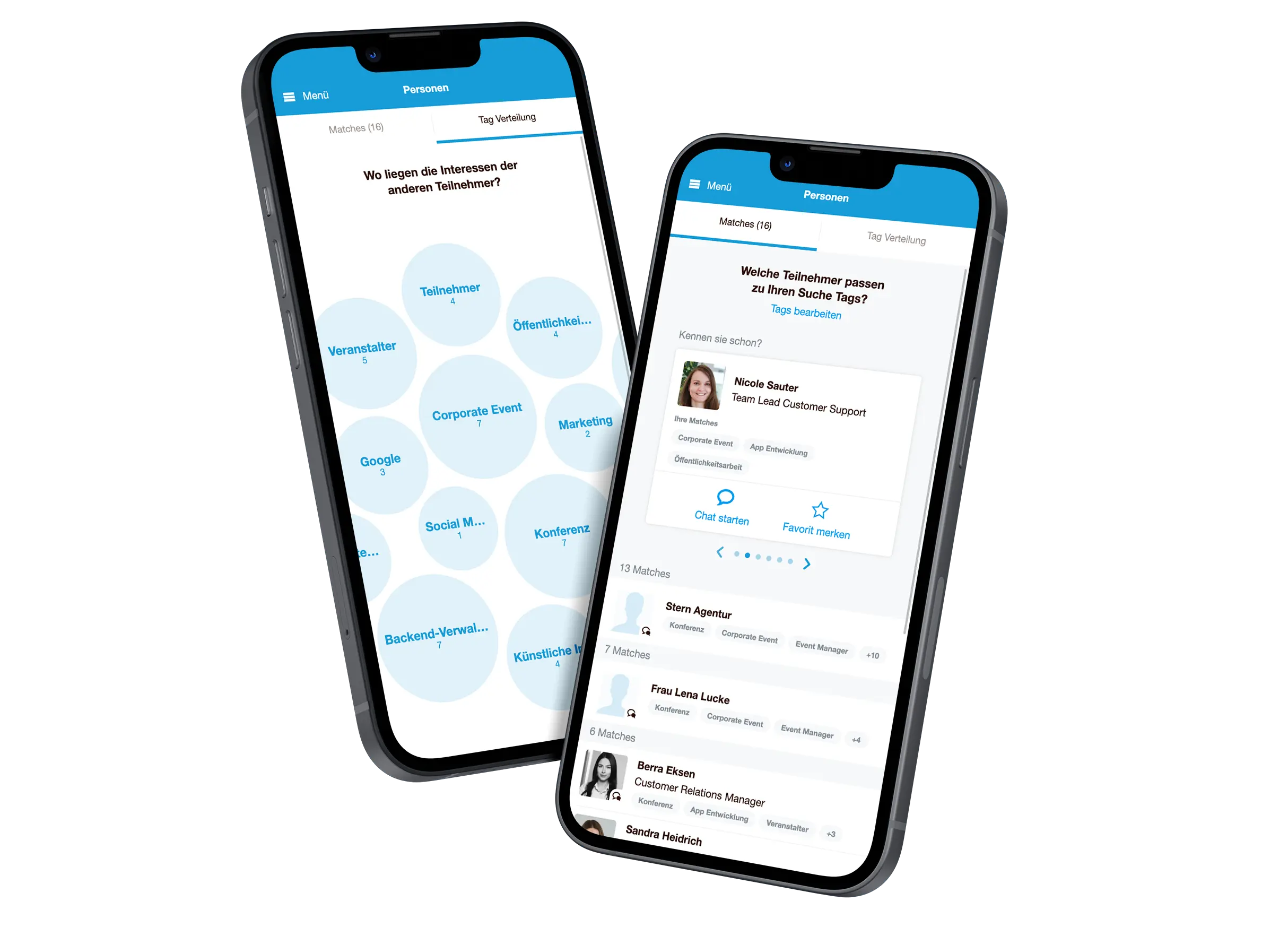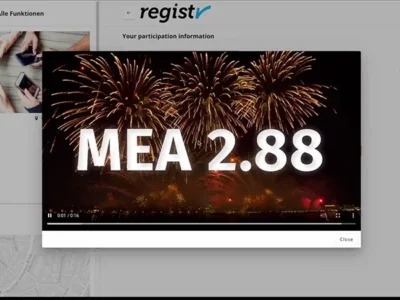
As an event planner, you know that personal encounters at in-person events are worth their weight in gold. This isn’t just about a quick exchange of business cards. It’s about creating real and deep connections that build lasting relationships and leave unforgettable memories. But in an ever-changing world, participants are looking for something special, for experiences that inspire and enrich. That’s where innovative networking ideas come in to make your event a highlight.
Let’s dive right in and share these 10 networking ideas for your in-person events.
Table of contents
- Speed dating
- Networking lounges
- Theme tables
- Barcamps
- Buddy system
- Digital tools
- Networking games
- Pre-event
- 1:1 Meetings at events
- Evening event
- Event app for better networking
1. Speed dating: networking on the fly
You probably know speed dating as a quick way to meet potential partners. But the secret of speed dating lies in its efficiency. Imagine that in just a few minutes, your event attendees could meet a multitude of like-minded people. As soon as time runs out, they move on to the next interlocutor. It’s a dynamic process that speeds up getting to know each other and goes far beyond traditional networking.
Adaptation of the format for professional events
The speed dating principle can be easily adapted for your events. Here, the focus is not on romance, but on professional exchange. Instead of talking about hobbies, attendees exchange ideas about industry trends or business ideas. With targeted questions or topics, you can ensure that the conversations go in the desired direction.
Advantages and challenges of the speed dating format
Advantages:
-
- Efficient networking: Many different people can be met and got to know in a short time
- Active participation: Every participant is actively involved and has the chance to present him/herself
- Barrier reduction: The format can help to quickly overcome initial inhibitions or uncertainties
Challenges:
-
- Time pressure: The short call time may be perceived as stressful or restrictive.
- Comfort zone: Not everyone feels comfortable in this format or dares to actively participate.
- Unbalanced conversations: Sometimes one participant may dominate the conversation while the other hardly gets a chance to speak.
2. Networking lounges: Relaxed networking in a stylish ambience
Imagine your attendees being able to retreat to a quiet corner to have in-depth conversations in a relaxed atmosphere. That’s exactly what networking lounges offer. They are the perfect place for quality interactions away from the hustle and bustle of the event.
What makes a networking lounge so special?
The special thing about a networking lounge is its well thought-out design. It offers an oasis of calm in the middle of the event action. Comfortable seating, atmospheric lighting and perhaps even discreet background music create an atmosphere that invites you to linger and network.
Benefits and challenges of networking lounges
Benefits:
-
- Quality over quantity: deeper and more meaningful conversations emerge in the lounge
- Versatility: Whether one-on-one or group discussions, everything is possible here.
- Increase event satisfaction: A sophisticated lounge enhances the event experience.
Challenges:
-
- Space requirements: Not every venue offers enough space for a lounge.
- Costs: A lounge may incur additional costs.
- Noise interference: Poor placement can cause noise interference.
3. Theme tables: Targeted networking according to areas of interest
You know the problem: At large events, it is often a challenge to find the right discussion partners. With theme tables, you offer your participants a targeted solution to exchange ideas according to their areas of interest and make valuable contacts.
How to choose the right topics
The key to the success of theme tables is selecting relevant and current topics. Use surveys or pre-surveys to find out which topics are of particular interest to your participants. Be it industry trends, innovative technologies or best practices – make sure your topic selection is diverse and engaging.
Tips for the organization and implementation
-
- Labeling: Make it easy for your participants by clearly labeling each table with its topic.
- Moderation: An expert or moderator can guide the conversation and ensure that all participants have their say
- Time management: set time limits to keep discussions focused and provide opportunities to visit different tables.
- Materials: provide handouts or infographics to enrich the conversation.
Advantages and challenges from the theme table
Advantages:
-
- Targeted networking: Participants quickly find like-minded people.
- Efficiency: No more aimless wandering in search of interesting conversation partners.
- Variety: The possibility to visit different tables offers variety.
Challenges:
-
- Topic relevance: Not all topics may be of interest to every participant.
- Space requirements: Sufficient space is needed to accommodate various tables
- Time Management: Coordinating change can be challenging.
4. Barcamp: The democratic format for active networking
A barcamp, often called an “unconference,” offers a refreshing change from traditional conferences and workshops. It’s an open, democratic format where you, the event planner, don’t need a set agenda or predetermined speakers. Instead, your participants have the freedom to shape the agenda themselves and actively participate in the knowledge exchange.
Share topic ideas and audience voting
After the topics are presented, participants vote on which sessions they find most interesting. The topics with the most votes are included in the schedule. This democratic approach ensures that the content is relevant to the majority of those present.
Advantages and challenges of the format
Advantages:
-
- Focus on participants: The barcamp focuses on the interests and knowledge of the participants.
- Diverse topics: Anyone can contribute, resulting in a wide variety of topics.
- Pure networking: The open format promotes exchange and the establishment of contacts.
Challenges:
-
- Unpredictability: Without a set agenda, planning the day can be challenging.
- Fluctuating quality: Since there are no fixed speakers, the quality of the sessions may vary.
- Active participation needed: some participants may find it difficult to get actively involved.
5. Buddy System: Networking made easy for event newcomers
You know how it is: At large events, it can be challenging for newcomers to take the first step and network. That’s where the Buddy System comes in! By placing an experienced “event bunny” at the side of an event newbie, you create a bridge that makes networking easier and more effective.
How the Buddy System promotes networking
The concept is simple: newcomers or first-time visitors to your event are paired with experienced participants. These “buddies” are not only guides, but also door openers to a broader network. They establish contacts, provide tips on interesting discussion partners and help overcome inhibition thresholds.
Advantages and challenges of the Buddy System
Advantages:
-
- Faster entry: Newcomers find their way around more quickly thanks to the support of an experienced “buddy” and can thus enjoy the event to the full from the start.
- Effective networking: With a “buddy” at their side, newcomers can make contacts more easily because the experienced partner already has an existing network and can provide recommendations.
- Increase attendee satisfaction: feeling supported and not left alone can significantly increase satisfaction and engagement among event newcomers.
Challenges:
-
- Matching pairings: It can be a challenge to pair the right “buddies” with newcomers so that both sides benefit from the partnership.
- Buddies’ commitment: Not every experienced participant is automatically a good “buddy.” It takes commitment and the willingness to actively support.
- Additional organizational effort: implementing and managing a buddy system can take additional resources, especially for large events.
6. Digital Tools: Technology-enabled networking
In today’s digital era, technology-enabled solutions offer event planners a goldmine of opportunities to intensify the networking experience of their attendees. These tools go far beyond the traditional face-to-face meeting and create new dimensions of exchange.
Innovative platforms for modern networking
Digital platforms offer a wealth of opportunities to bring people together. They enable participants to interact with each other before, during and after the event.
-
- Event apps: These apps are not only sources of information, but also networking powerhouses. With integrated chats, dedicated discussion channels, and matchmaking features, you can specifically network your attendees.
- Virtual business cards: Forget the hassle of collecting physical cards. With digital profiles, your participants can share contact information with one click – efficiently and environmentally friendly.
Find out which functions an event app should offer for networking in the blog post: Successful networking with the right event app: These 3 functions should not be missing
Benefits and challenges of digital tools
Benefits:
-
- Efficiency and reach: Digital tools make it possible to get in touch with a large number of people in a short time, regardless of geographical boundaries.
- Targeted networking: Matchmaking features and algorithms allow participants to be targeted for networking based on their interests, skills, or professional backgrounds.
- Data analytics: Digital platforms often offer analytics that provide valuable insights into attendee behavior and preferences, making it easier to plan future events.
Challenges:
-
- Data protection: The use of digital tools increases the risk of data breaches. It is critical to choose platforms that offer strong security measures and comply with data protection laws.
- Technical issues: Technical outages or problems can affect the networking experience and cause frustration among participants.
- Learning curve: Not all participants are tech-savvy. It can be a challenge to ensure that everyone is familiar with the tools and can use them effectively.
7. Networking games: Encouraging fun and interaction
Networking can sometimes be intimidating, especially in large groups or when many participants don’t know each other. Networking games are an excellent way to break the ice, lighten the mood, and help participants connect with each other in a fun way.
3 creative game ideas for getting to know each other
Bingo with facts: Each cell of the bingo card contains an interesting fact, such as “Has done skydiving before” or “Speaks two languages fluently.” The challenge for participants is to find colleagues who match the descriptions and fill in their card.
Card swap: Everyone receives a card with a certain word or picture. The task? Find someone with a complementary card. For example, someone might have a card with a key and another with a lock.
Networking Poker: Here, participants are dealt a handful of cards, each with a specific networking task or question. The goal is to “get rid” of as many cards as possible by completing the tasks or asking questions.
Advantages and challenges of networking games
Advantages:
-
- Breaking down barriers: Games can help overcome initial inhibitions and promote communication.
- Customizability: There are a variety of games that can be customized as needed.
- Ease of implementation: Many games require minimal preparation and materials.
Challenges:
-
- Not suitable for everyone: Games may make some people uncomfortable.
- Choosing the right game: Not every game fits every target group or event.
- Time management: Some games might take longer than expected.
8. Pre-event: Laying the foundation for successful networking
Before the main event even begins, a pre-event can make all the difference. They offer participants an exclusive opportunity to get to know each other in a more relaxed atmosphere, paving the way for deeper and more productive interactions during the main event.
Benefits and challenges of a pre-event for networking
Benefits:
-
- Early networking: Even before the main event begins, your participants already have the opportunity to make valuable contacts.
- More intimate atmosphere: often pre-events are smaller and less hectic, allowing for deeper and higher quality conversations.
- Build familiarity: early interactions can help your participants feel more familiar and confident during the main event.
Challenges:
-
- Potentially lower attendance: not everyone who attends the main event can also attend the pre-event.
- Additional Costs: For those traveling from further away, there could be additional costs for accommodations or travel.
- Risk of exclusivity: too specific a focus of the pre-event could make some participants feel that they will not find the right contacts or even be excluded.
9. 1:1 meetings at events: Effective networking through targeted appointments
Enhance the networking experience at your event by allowing your attendees to set up 1:1 meetings with other attendees in advance. This not only encourages interaction, but also ensures that each encounter is valuable and purposeful.
How does this work?
Matchmaking tools and event apps: These digital helpers enable participants to identify potential interlocutors based on common interests or goals in advance of the event and set up appointments with them.
Clear meeting points: With dedicated areas, such as lounges or numbered tables, your participants will find each other easily. This ensures a smooth flow and minimizes possible confusion.
Appointment slots for networking: A time period reserved specifically for 1:1 meetings ensures that your participants do not have to switch back and forth between different program items. This enables focused and high-quality conversations.
Advantages and challenges
Advantages:
-
- Flexibility: Whether in person or digitally – 1:1 meetings adapt to the needs of your participants.
- Intensive conversations: in a 1:1 setting, topics can be discussed in greater depth, leading to more valuable insights.
- Targeted networking: Your participants meet exactly the people who are relevant to them, resulting in high-quality interactions.
Challenges:
-
- Schedule management: Especially for large events, coordinating 1:1 meetings can be logistically challenging.
- Technical hurdles: Digital tools can sometimes present technical problems.
- Space requirements: For large events, it can be challenging to provide enough suitable venues for 1:1 meetings.
10. Evening event: Networking in a relaxed atmosphere
Evening events are much more than just a leisurely end to an intense day. They provide a strategic opportunity to deepen networking. In a relaxed environment, participants can build authentic relationships and make contacts that extend beyond the formal program of the main event.
Advantages and challenges
Advantages:
-
- Authentic encounters: In a relaxed atmosphere, participants can get to know each other better beyond formal discussions and presentations.
- Extended networking time: Evening events extend the time for exchange, which is particularly valuable when the day’s program is packed.
- Creative networking approach: The evening offers space for innovative networking activities that might not be possible during the day.
Challenges:
-
- Background noise: Music and conversations can drive up the noise level, which can make deep conversations difficult.
- Energy Level: After a full day, some participants may be tired and less focused on networking.
- Organizational Requirements: A successful evening event that both entertains and promotes networking requires careful planning and coordination.
Event app to support networking
As mentioned earlier, as a provider of a Software as a Service event platform, we would like to go into more detail about the use of event apps. An event app not only offers a platform for effective networking, but also innovative solutions to seamlessly integrate and optimize the ideas presented in the article. Some of the proposed topics can thus be ideally implemented via an event app. At the same time, it offers your participants a better way to communicate with each other and stay informed themselves.
In addition to the optimized realization of the proposed ideas, an event app also helps with a variety of useful features and functions whose potential is just waiting to be exploited by you.
Some of these functions and features are:
- Digital profiles and matchmaking
With an event app, attendees can create their professional profiles and connect with others who have similar interests or goals. This promotes targeted and meaningful connections.
- Interactive agenda
The app can provide an interactive agenda where attendees can add sessions, workshops, or networking events they would like to attend. This makes it easier to schedule and coordinate 1:1 meetings
- Real-time notifications.
Notifications of upcoming networking events or reminders of scheduled meetings can ensure attendees never miss a networking opportunity
- Interactive maps
A map of the venue can help attendees easily find networking areas, lounges, or special meeting spots.
- Feedback and surveys
After each networking event, attendees can provide feedback or participate in surveys. This gives event organizers valuable insights to improve future events.
- Social media integration
The ability to share networking experiences on social media can increase the visibility of the event and attract more attendees.
- Gamification
By adding gamified elements, such as point systems or rewards for active networking, the app can motivate attendees to network more.
Conclusion
Networking is at the heart of every event. As we have seen, a variety of approaches exist to promote exchange. Whether through speed dating, networking lounges, topic-focused tables, or the use of digital tools, there are numerous ways that event organizers can enhance the networking experience.
Evening events deepen relationships in casual settings, while the buddy system and 1:1 meetings provide targeted interactions. Games and interactive formats lighten the atmosphere and make it easier to get to know each other. Pre-events, in turn, lay the foundation for successful networking.
Regardless of the approach chosen, the focus should always be on the well-being of the participants in order to facilitate authentic networking. With rapid digitization and new technologies, networking opportunities will continue to expand. It remains exciting to see what innovations the future holds in store.
In addition, digital tools, such as event apps, provide a convenient way to easily and quickly provide each person with information and improve communication with each other. At the same time, these tools enable new and interactive ways to communicate and interact with each other. Especially for networking, innovation and thinking along are among important factors for a successful event.
With the right strategy and openness to innovations, your events can become genuine networking centers that not only impart knowledge, but also valuable contacts.




